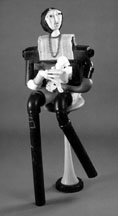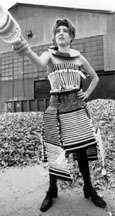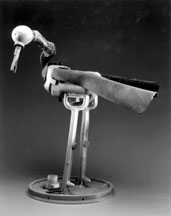
Jerry Barrish's "Lady From Krakow" makes elegant use of society's discards.
Your garbage may be a work of art
By Annelise Sorensen
Imagine Rodin's The Thinker fashioned entirely out of discarded toothbrushes, or Jean-Paul Gaultier's flared pants cut and sewn from heavy-duty bubble wrap. If recycling has been the buzz word of the last decade, art from recyclables appears to be the natural next step in the environmental movement. In the last two years, several exhibits showcasing artists who use recycled materials in their work have opened across the nation, from "Hello Again: Recycling for the Real World" at the museum of the Fashion Institute of Technology in New York to "The Object Redux: Re-Used, Re-Newed and Re-Invented" at the Charles A. Wustum Museum in Racine, Wisconsin. Next February, the Oakland Museum will follow suit with a large-scale retrospective on recycled art. Luckily for the curators, the Bay Area has long been home to artists who create from such discarded materials as bottle tops, mosquito netting and milk cartons.
For Estelle Akamine, it all began one day at the San Francisco dump in 1993. Akamine spent six months as artist-in-residence at what is officially known as The Sanitary Fill Company's NorCal Transfer and Recycling Facility. Artists are set up in a studio at the dump site and given free rein to collect trash to incorporate into their pieces. The program's slogan says it all: "Make art, not landfill." Akamine's project was to fashion formal wear for volunteers from the dump to wear at that year's ritzy Black & White Ball. That's right, formal wear. Says Akamine, "I wove dozens and dozens of cummerbunds, capes, dresses and skirts out of plastic bags, computer ribbon, records, mini-blinds and six-pack plastic holders."

Estelle Akamine's "Bubble Dress" transforms bubble pack and foam sheet into high fashion.
Akamine started her artistic career as a weaver, and she employs traditional weaving techniques on wholly untraditional materials. "For my Audrey Hepburn dress," she says, "I wove a bustle out of four strips of foam, finishing off each strip with a bow tie." For another garment, a bustier and mini-skirt creation, she cut 60 plastic bottles lengthwise to weave a sparkling, flouncy skirt. Perhaps the pieces that have attracted most attention are her designs fashioned entirely of shredded money, courtesy of the Federal Reserve Bank.
Akamine's money jacket and matching hat, shimmering with cascading layers of shredded bills, proved a hit in a recent exhibit by the Bay Area's Earthsake stores. Earthsake co-owner Elly Katz curated the show, displaying in her store windows works by a group of local artists who make use of recycled products. "My goal was to show the layperson that what we all view as trash is not really trash," says Katz. "Most people don't regularly visit galleries, but everyone shops, and I hope that through these displays I helped people to look at their trash differently."
Clothing is for wearing, and Akamine's designs can be comfortably worn--and even danced in. In 1994, she received a grant from the SF Art Commission to participate in the "Art on Market Street" project. Businesses donated their "waste," and Akamine spun her magic, creating a wild line of costumes out of packing peanuts from Sharper Image, tubes and caps from the Body Shop, and plastic bags from the Men's Wearhouse. A local dance troupe, outfitted in Akamine's artistic creations, promenaded down Market Street drumming on recycled Alhambra bottles.

For Akamine, the choice to design clothes is as much a political as an artistic one. She explains, "People can easily reject a sculpture because it can be too elitist for the common person. Through my clothing, I hope that I inspire people to realize that recycling can be beautiful and useful."
Creating clothing as art is an effective way of reminding the public that there can be more than one use for the same object, a key tenet in the environmental movement. "I want the public to be inspired by my creations," Akamine says. "I don't want to hit them over the head with slogans about saving the environment, but instead to persuade them that this is the better road to take. I want the public to see the benefits of recycling when they view my clothes."
Artist Jerry Barrish's interest in recycled art materials began in 1989, when he was walking on the beach outside his home in Pacifica. He could hardly see the sand and surf for all the plastic litter. "I was frustrated by all the plastic, and I decided to collect it and make a Christmas tree," Barrish says. "Then I made Christmas ornaments." He was hooked and has been creating figurative sculptures out of recycled plastic products ever since.
Recycled art has close ties to the Assemblage movement, in which artists also use found materials in their art. In fact many, like Barrish, believe that the two movements are essentially the same. For Barrish, it is secondary that the items he uses are recycled products. He has consistently participated in Earth Day exhibits and shows regularly on the recycled art circuit, but says, "I want my work to be accepted for the work and not for the materials it's made out of."

If you've ever secretly wondered whether your trash will one day come back and haunt you, one visit to Barrish's Potrero Hill studio will confirm your suspicions. The first impression is of a toy store come to life after the last employee has gone home for the night and the ringleader--there's always a ringleader--has given the signal for all the toys to come out and play. Here is the afterlife world of inanimate objects reborn in a different form. In one corner, a jazz pianist dreamily plays the piano, his fingers rippling over the keyboard--all made of white Bic lighters. A trio of brightly colored squawking parrots flap their wings, cunningly fashioned out of discarded combs. Commanding another corner of the studio is Dizzy Gillespie, his torso, made from a misshapen piece of black tubing, seeming to undulate as he expertly blows his horn.
Barrish started his art education studying to be a traditional sculptor, eventually changing his major to filmmaking. He received his MFA from the SF Art Institute. "I try to get motion and gesture into my works," he explains, "and this comes from the filmmaking aspects of my life." His sculptures are alive with movement, from a rendering of Don Quixote astride his horse to a piece titled Hula Lamp, a humorous takeoff on that rotating house-ornament fad of the '50s and '60s.
As detailed as many of Barrish's sculptures are, each work seems to center around a single object. In Blue Parrot Cafe, named after the cafe in the movie Casablanca, two men sit at a table with a parrot swinging above them. One man wears a red plastic bowl on his head. Barrish's brilliant touch is in the single tassel sprouting from the center of the bowl. Of course. The man is wearing a fez. Immediately, the entire cafe scene--and the connection with the movie--comes to life. Barrish, standing in the middle of his studio, gestures toward the art piece.
"It all started with the fez," he says.
[ SF Live | MetroActive Central | Archives ]
